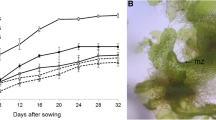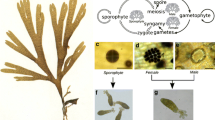Abstract
Drynaria bonii H. Christ is a medicinal plant that has traditionally been used for the treatment of chronic diseases and tuberculosis. However, D. bonii has not yet been cultivated or propagated. In this study, we optimized the conditions for the spore culture of D. bonii to produce sporophytes. First, we evaluated the effects of various factors, such as temperature, light intensity, potting material, and pH, on spore germination and early gametophyte development. Under optimal culture conditions, 95–99% of the spores germinated within 2 weeks of culture. Next, based on these results, we established a culture system for gametophyte development and sporophyte production. Mature gametophytes first appeared 5 months post-germination (mpg), and at 12 mpg, the rate of production of heart-shaped gametophytes reached 56.6%. Sporophytes at the early first-leaf stage first appeared at 6 mpg, and at 12 mpg, the rate of formation of sporophytes reached 15.4%. Interestingly, 6.3% of all gametophytes produced multiple sporophytes. Additionally, 42–62% of the gametophytes also produced multiple secondary gametophytes, indicating a high potential of D. bonii gametophytes to generate new gametophytes and, subsequently, sporophytes. When transferred to new trays or pots, sporophytes grew well and showed 100% survival. Overall, we conclude that this spore culture system can be successfully used for the propagation of D. bonii sporophytes.





Similar content being viewed by others

References
Aspiras RA (2010) Sporophyte and gametophyte development of Platycerium coronarium (Koenig) Desv. and P. grande (Fee) C. Presl. (Polypodiaceae) through in vitro propagation. Saudi J Biol Sci 17(1):13–22
Ban NT, Ly TD, Tap N, Dung VV, Thin NN, Tien NV, Khoi NK (2007) Vietnam Red Data Book, vol II. Plants. Natural Science and Technology Publishing House, Hanoi (in Vietnamese)
Chang HC, Agrawal DC, Kuo CL, Wen JL, Chen CC, Tsay HS (2007) In vitro culture of Drynaria fortunei, a fern species source of Chinese medicine “Gu-Sui-Bu”. In Vitro Cell Dev Biol Plant 43:133–139
Chao YS, Liu HY, Huang YM, Chiou WL (2010) Reproductive traits of Pteris cadieri and P. grevilleana in Taiwan: Implications for their hybrid origin. Bot Stud 51(2):209–216
Cousens MI (1979) Gametophyte ontogeny, sex expression, and genetic load as measures of population divergence in Blechnum spicant. Am J Bot 66(2):116–132
eFloras (2008) eFloras. Missouri Botanical Garden, St. Louis; Harvard University Herbaria, Cambridge. https://www.efloras.org. Accessed 22 Feb 2018
Elkington BG, Southavong B, Sydara K, Souliya O, Vanthanouvong M, Nettavong K, Thammachack B, Pak DH, Riley MC, Franzblau SG, Soejarto DD (2009) Biological evaluation of plants of Laos used in the treatment of tuberculosis in Lao traditional medicine. Pharm Biol 47(1):26–33
Fernández H, Kumar A, Revilla A (2010) Working with ferns: issues and applications. Springer Science and Business Media, New York
Fraser-Jenkins CR (2012) Rare and threatened Pteridophytes of Asia 2. Endangered species of India—the higher IUCN categories. Bull Natl Museum Nat Sci Ser B 38:153–181
Jang BK, Cho JS, Kwon HJ, Lee CH (2019) Optimal conditions for spore germination and gametophyte and sporophyte production in the autumn fern Dryopteris erythrosora. Hortic Environ Biotechnol 60(1):115–123
Klekowski EJ Jr (1972) Evidence against genetic self-incompatibility in the homosporous fern Pteridium aquilinum. Evolution 26:66–73
Loi DT (2004) Vietnamese medicinal plants and remedies. Medical Publishing House, Hanoi (in Vietnamese)
Mikuła A, Jata K, Rybczyński JJ (2009) Cryopreservation strategies for Cyathea australis (R. BR.) domin. CryoLetters 30(6):429–439
Nayar B, Kaur S (1971) Gametophytes of homosporous ferns. Bot Rev 37(3):295
Nondorf SL, Dooley MA, Palmieri M, Swatzell LJ (2003) The effects of pH, temperature, light intensity, light quality, and moisture levels on spore germination in Cheilanthes feei of Southeast Missouri. Am Fern J 93(2):56–69
Raghavan V (2005) Developmental biology of fern gametophytes, vol 20. Cambridge University Press, Cambridge
Trinh P, Tri M, An N, An P, Minh P, Dung L (2015) Phenolic compounds from the rhizomes of Drynaria bonii. Chem Nat Compd 51(3):476–479. https://doi.org/10.1007/s10600-015-1318-4
Trinh PTN, Tri MD, Hien DC, An NH, Minh PN, An PN, Dung LT (2016) A new flavan from the Drynaria bonii H. Christ rhizomes. Nat Prod Res 30(7):761–767. https://doi.org/10.1080/14786419.2015.1063054
Viviani D, Randi ÁM (2008) Effects of pH, temperature and light intensity on spore germination and growth analysis of young sporophytes of Polypodium lepidopteris (Pteridophyta, Polypodiaceae). Rodriguésia 59(4):751–760
Wu H, Liu XQ, Ji H, Chen LQ (2010) Effects of light, macronutrients, and sucrose on germination and development of the endangered fern Adiantum reniforme var. sinense (Adiantaceae). Sci Hortic 125(3):417–421. https://doi.org/10.1016/j.scienta.2010.03.004
Acknowledgements
This work was supported by the Hanoi National University of Education, Vietnam (Grant no. SPHN-17-11) and the Basic Science Research Program through the National Research Foundation of Korea (NRF) funded by the Ministry of Education (2016R1A6A1A03012862).
Author information
Authors and Affiliations
Corresponding authors
Additional information
Publisher's Note
Springer Nature remains neutral with regard to jurisdictional claims in published maps and institutional affiliations.
Rights and permissions
About this article
Cite this article
Van Nguyen, Q., Khuat, H.T., Nguyen, YN.T. et al. Drynaria bonii spore culture: optimization of culture conditions and analysis of gametophyte and sporophyte development. Plant Biotechnol Rep 14, 575–584 (2020). https://doi.org/10.1007/s11816-020-00632-7
Received:
Accepted:
Published:
Issue Date:
DOI: https://doi.org/10.1007/s11816-020-00632-7



